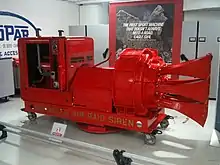Chrysler Air-raid Siren
The Chrysler Air Raid Siren (second generation), or known as the Chrysler Bell Victory Siren (first generation) is an outdoor warning siren produced during the Cold War era that has an output of 138 dB(C) at 100 feet (30 m).

History
Built during the Cold War era from 1952 to 1957 (second generation) by Chrysler, its power plant contained a newly designed FirePower Hemi V8 engine with a displacement of 331 cubic inches (5.42 l) and producing 180 horsepower (130 kW).[1]
They are 12 feet (3.7 m) long, built atop a quarter section of a Dodge truck chassis rail, and weigh an estimated 3 short tons (2.7 t). Its six horns are each 3 feet (91 cm) long. The siren has an output of 138 dB(C) (30,000 watts), and can be heard as far as 25 miles (40 km) away.
In 1952, the cost of a Chrysler Air-raid Siren was $5,500[1] (equivalent to $52,953 in 2019). The United States government helped buy sirens for selected state and county law enforcement agencies. In Los Angeles County, six were placed around key locations of populated areas, and another ten were sold to other government agencies in the state of California. These "Big Red Whistles" (as they were nicknamed) only saw testing use. Some were located so remotely that they deteriorated due to lack of maintenance.
The main purpose of the siren was to warn the public in the event of a nuclear attack by the Soviet Union during the Cold War. The operator's job was to start the engine and bring it up to operating speed, then to pull and release the transmission handle to start the wailing signal generation. The Chrysler air raid siren produced the loudest sound ever achieved by an air raid siren.[1]
Today
Some sirens are still located above buildings and watchtowers. Many are rusted, and in some cases, the salvage value is less than the cost to remove them. A majority have been moved to museums, and some have been restored to fully functioning condition.
Cities with Chrysler Sirens
| City, State | Number of sirens, Status |
|---|---|
| Chicago, Illinois | 5, removed |
| Dayton, Ohio | 4, removed |
| Detroit, Michigan | 20, removed |
| Grand Rapids, Michigan | 4, status is unknown |
| Greenville, South Carolina | 1, standing, non-operational |
| Horsham, Pennsylvania | 1, removed |
| Jackson, Michigan | 1, removed and replaced with a Thunderbolt in 1982 |
| Kansas City, Missouri | 3, 2 removed, 1 non-operational[2] |
| Lansing, Michigan | 1, removed |
| Los Angeles County, California | 24, most removed, a few still in place and non-operational |
| Miami, Florida | 10, removed |
| Newark, Delaware | 1, removed |
| Oakland, California | 5, removed |
| Pittsburgh, Pennsylvania | 10, 2 removed and in private possession[3][4][5][6] |
| Portland, Oregon | 7, removed[7] |
| Rochester, New York | 2, 1 standing, other one's status is unknown |
| Rockford, Illinois | 3, removed, one in private possession |
| Salt Lake City, Utah | 3, removed |
| San Francisco, California | 1, removed |
| Seattle, Washington | 6, 4 removed, 2 standing and non-operational |
| Spokane, Washington | 2, status is unknown |
| Trenton, Michigan | 3, removed |
References
- VictorySiren.com
- Donald Bradley (January 22, 2018). "In case of nuclear attack, Kansas City says it's ready. Here's why". The Kansas City Star.
- "City to Test New Air Raid Siren April 1". The Pittsburgh Press. March 24, 1953.
- "Archived copy". antiqueweekend.com. Archived from the original on 2015-03-28. Retrieved 2014-11-30.CS1 maint: archived copy as title (link)
- "Archived copy". antiqueweekend.com. Archived from the original on 2015-05-06. Retrieved 2014-11-30.CS1 maint: archived copy as title (link)
- "Archived copy". antiqueweekend.com. Archived from the original on 2015-05-06. Retrieved 2014-11-30.CS1 maint: archived copy as title (link)
- http://wailingwillie.blogspot.com/